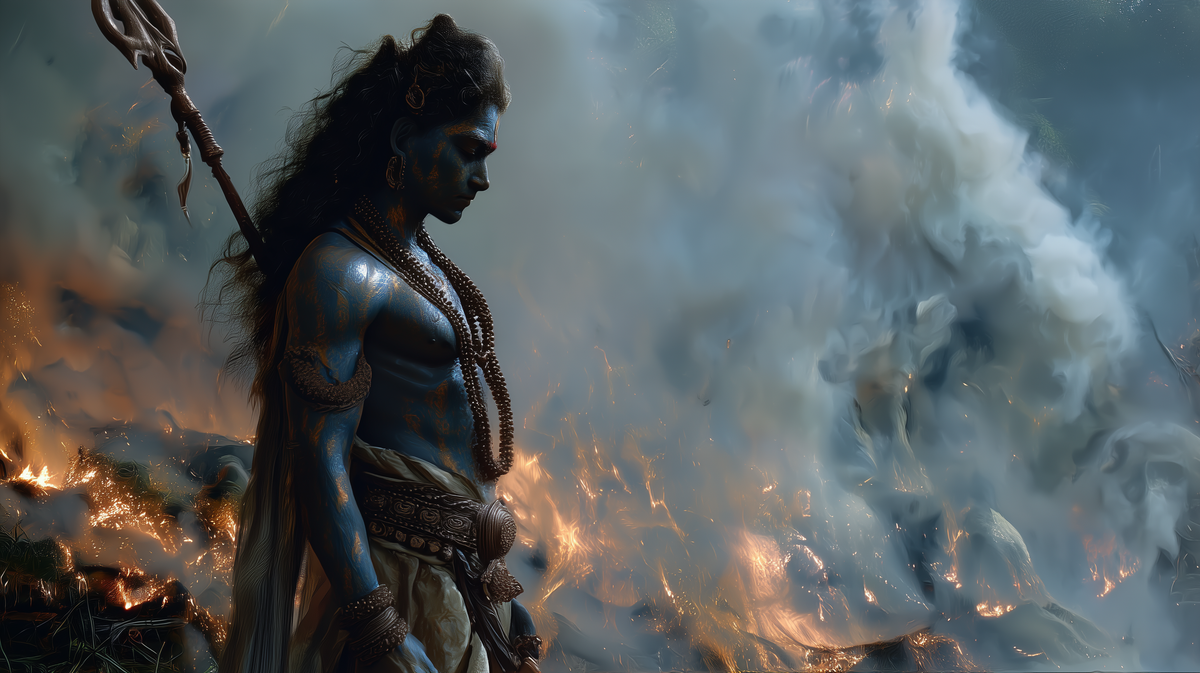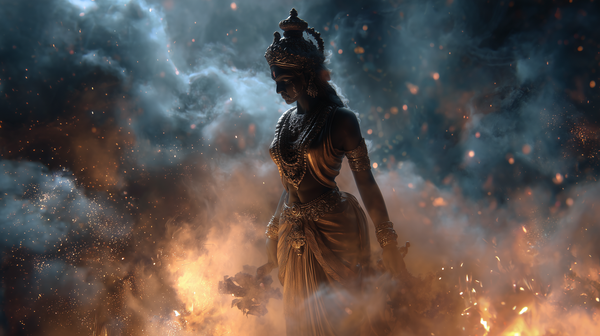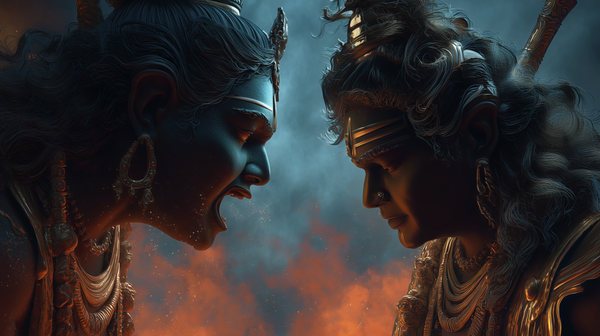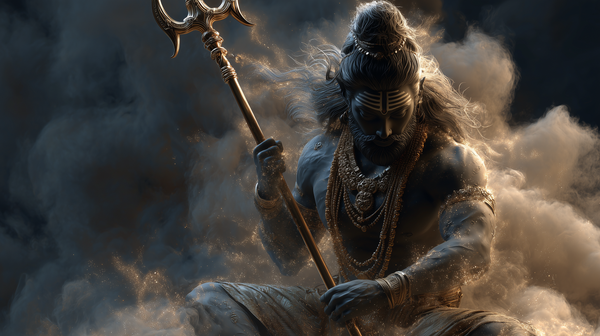Bhairava Sadhana: Before the Basics
Sacred Knowledge for Modern Practitioners

This article is derived from Guruji’s video lecture, Satsang, Praveen Radhakrishnan. All content and intellectual property rights belong to Guruji and the KaliPutra Mission
Understanding the Purpose: Liberation and Karmic Resolution
The fundamental purpose of Bhairava Sadhana emerges clearly from the opening teachings [00:00:08]. This ancient practice serves two primary spiritual objectives: achieving Moksha (liberation from the cycle of rebirth) for those destined for such liberation, or systematically burning residual Karma that perpetuates endless cycles of birth and death. Unlike souls who return to physical form for divine missions—such as avataras or great rishis who come with specific dharmic purposes already known to them [00:01:12]—most practitioners seek to escape the binding wheel of samsara entirely.
The teaching emphasizes that residual Karma represents the accumulated actions and consequences from past lifetimes that keep souls tethered to reincarnation [00:31]. Those exceptional beings who have completely exhausted their Karma but still choose rebirth do so only to fulfill sacred duties or respond to cosmic needs. For ordinary seekers, however, Bhairava Sadhana offers the most direct path out of the cycle of life and death, making it "the crux" of spiritual liberation [01:56].
Historical Context: Bhairava's Relevance in Kali Yuga
The historical suppression of Ugra Shaktis (fierce deities) provides crucial context for understanding Bhairava's contemporary significance [02:13]. Over the past millennium, particularly during British colonial rule, practitioners of intense spiritual paths—especially those dwelling in smashanas (cremation grounds)—faced systematic marginalization because their practices appeared extreme and incomprehensible to foreign administrators [03:05]. This suppression was part of the natural Kala Chakra (cosmic cycle), leading to the decline of fierce worship traditions while gentler, more universally accessible deities flourished.
However, around 2018, a significant shift occurred in the cosmic wheel, heralding a "huge upswing in dharmic activities" and renewed interest in Bhairava worship [03:39]. This resurgence aligns perfectly with Bhairava's role as the preeminent deity for Kali Yuga—the current age characterized by the breakdown of established norms and traditional procedures. Bhairava's power manifests most powerfully during periods of "procedural collapse," when rigid rules and social structures begin crumbling [04:15]. The mythological account of Bhairava's first act—beheading Brahma himself, considered the gravest sin (Brahmahatya) in dharmic tradition—illustrates his unique nature as a deity who emerges precisely when conventional cosmic order dissolves.
The Unconventional Path: Beyond Traditional Dharmic Norms
Understanding Bhairava requires embracing a fundamental paradox [05:30]: the spiritual path He guides often involves actions and experiences that seem contrary to conventional religious or social expectations. This contradiction represents "the crux of Bhairava"—wherever procedural collapse occurs, traditional offerings and worship methods become irrelevant [05:46]. The ultimate realization in Bhairava Sadhana involves reaching a state where one perceives no difference between ritually pure offerings (like milk) and substances typically considered inappropriate for sacred spaces [06:31]. This non-dual awareness transcends conventional notions of purity and impurity, marking genuine spiritual progression.
The goal is not renunciation of worldly life but rather skillful engagement with modern existence while simultaneously burning accumulated Karma and avoiding the creation of fresh karmic debts [06:58]. Practitioners need not adopt monastic lifestyles; instead, they should live authentically in their current era—working with computers, dealing with traffic jams, fulfilling contemporary responsibilities—while using these very experiences as vehicles for spiritual purification [07:47]. Attempting to escape life's challenges by retreating to ashrams or avoiding problems merely postpones karmic resolution rather than accomplishing genuine liberation.
Practical Entry Points: Mantras and Sacred Texts
For beginning practitioners, several accessible entry points facilitate safe initiation into Bhairava Sadhana [08:57]. Studying the 1008 names of Bhairava (Ashtottara Shatanamavali) provides foundational understanding, while regular recitation of sacred hymns like the Kalabhairava Ashtakam establishes daily practice rhythms. Remarkably, formal initiation or elaborate instruction (upadesha) is unnecessary for these preliminary practices—sincere seekers can independently build comprehensive sadhanas from these texts [09:22].
The generic mantra "Om Bhairavaya Namaha" offers particular advantages for beginners due to its "formless" nature [09:22]. Unlike mantras tied to specific divine forms, this universal invocation dynamically adapts to each practitioner's unique karmic signature, manifesting the particular aspect of Bhairava most relevant to their current spiritual needs. Those nearing completion of their karmic cycles may find themselves rapidly drawn to Kalabhairava within one to three years [09:56], while others should avoid premature fixation on intense, fierce forms before developing the necessary spiritual maturity.
Karmic Realization and Spiritual Progression
A crucial milestone in Bhairava Sadhana involves developing the profound realization that one is merely "a latent stone" and all life experiences—positive or negative—result from earned Karma [11:07]. This includes fundamental relationships: whether parents were loving or harsh, supportive or neglectful, all such experiences represent "incurred and earned Karma" that must be systematically burned through spiritual practice. Past suffering should inspire gratitude rather than resentment, as it indicates successful completion of particular karmic cycles [11:41].
A fundamental principle for accelerating karmic resolution is avoiding complaint or protest during difficult periods [11:41]. As the sadhana deepens, practitioners begin perceiving the "karmic curtain"—a tightly woven tapestry of cause-and-effect relationships surrounding all existence [12:46]. This enhanced perception allows one to discern karmic linkages between events, understanding why specific jobs aren't obtained or particular postings occur. The timeline for developing this insight varies dramatically: some experience clarity within eleven days, others require years of consistent practice.
Additionally, advanced practitioners develop an internal guidance system—a "background voice" that helps distinguish actions leading to fresh Karma from those supporting liberation [12:46]. This intuitive guidance becomes increasingly reliable as the sadhana matures, helping navigate life's complexities while minimizing karmic accumulation.
Accelerating Karmic Burning Through Acceptance
When intense suffering arises during Bhairava Sadhana, the appropriate response involves complete acceptance without questioning or resistance [13:46]. Bhairava possesses the power to burn Karma while providing protective shelter during difficult transitions, but practitioners must personally "walk the Karma" and burn it through direct experience. The key to efficient karmic resolution lies in understanding why particular sufferings manifest rather than protesting their occurrence [14:06].
Repeatedly asking "why me" or denying personal responsibility delays the purification process [14:28]. Instead, practitioners should simultaneously maintain strong sadhana practice while cultivating the understanding that they are receiving precisely the karmic experiences they have earned. This dual approach—holding firmly to spiritual practice while accepting karmic consequences without protest—dramatically accelerates the burning process. When genuine understanding and acceptance develop, Bhairava can "accelerate karmic burning" so rapidly that suffering passes almost instantaneously [14:53].
The Ultimate Goal: Progression to Kalabhairava
The highest aspiration within Bhairava Sadhana involves graduating through various divine forms until reaching Kalabhairava, who serves as "the guru of Moksha"—the ultimate teacher of liberation [14:53]. This progression may span multiple lifetimes, particularly if the practitioner has outstanding dharmic duties requiring fulfillment. Such responsibilities might include establishing dharmic centers, initiating cultural transformation within spiritual communities, constructing temples, or serving as teachers for seekers who have become disconnected from authentic spiritual practice [15:09].
In Kali Yuga, many people have "strayed away from God" to such degrees that even temple worship lacks genuine engagement. Those called to address this spiritual crisis may require additional births to complete their service, though they will live well throughout this extended journey toward ultimate liberation.
Navigating Intensity: The Unique Pace of Bhairava Sadhana
Bhairava Sadhana distinguishes itself through the exceptional speed at which karmic burning occurs [16:00]. This accelerated pace proves overwhelming for many practitioners, as Bhairava directly confronts individuals with their "biggest fears and biggest pains." While some interpret these challenges as divine testing, they primarily represent the rapid surfacing of personal karmic accumulations that must be resolved. Many practitioners "fumble and drop out" when faced with this intensity, lacking the necessary mindset for successful completion.
The essential attitude involves accepting that one has earned whatever difficulties arise rather than wishing for karma to simply disappear [16:52]. Acceptance accelerates resolution, while resistance prolongs suffering. The goal is reaching a state where one has "lived well, not incurred fresh Karma, and completed most accumulated Karma" within the current lifetime—representing successful advancement on Bhairava's path [17:40].
Safe Beginning: Bala Bhairava and Preparatory Practices
For practical initiation, the recommended starting point involves working with Bala Bhairava (the child form) after completing preparatory practices [18:20]. Bala Bhairava embodies childlike qualities—"quick to forgive and quick to punish"—but His corrections carry the gentle nature of childhood rather than severe retribution. Practitioners should approach Him with the same love and spontaneity used when interacting with children.
However, attempting Bhairava Sadhana without proper preparation can create unnecessary obstacles [18:50]. The ideal progression begins with completing several anusthanas (practice cycles) dedicated to Ganesha, the remover of obstacles, before transitioning to Bala Bhairava. Skipping this preparatory phase often results in having to address complications that arise from inadequate foundational work.
The generic mantra "Om Bhairavaya Namaha" remains suitable for extended periods—even a full year or longer—because of its adaptable, formless nature [18:20]. Regular recitation of the Kalabhairava Ashtakam, preferably ten times daily, provides essential daily practice structure [20:54]. These foundational elements help build the spiritual capacity necessary for engaging with Bhairava's immense energy, which contains "the energy of Mahakala" and requires practitioners to be prepared for "karmic hits from multiple lifespans" [20:12].
Working with Spiritual Forces and Energetic Challenges
Advanced practitioners must also navigate the presence of various spiritual entities—including bhutas, pretas, and pishachas—who are drawn to Bhairava Sadhana [20:25]. These non-physical beings, seeking their own liberation, may create additional energetic challenges beyond personal karmic burning. Symptoms like persistent fatigue or depression during practice might indicate interference from these forces rather than purely personal karmic resolution.
Learning to contain and work skillfully with these energies represents an important aspect of mastering Bhairava Sadhana. The practice requires developing the ability to distinguish between authentic karmic burning and external spiritual influences, ensuring that the primary focus remains on personal liberation rather than being overwhelmed by surrounding energetic phenomena.
Through understanding these foundational principles and maintaining consistent, reverent practice, sincere seekers can safely embark upon the profound transformational journey that Bhairava Sadhana offers—ultimately leading to the complete exhaustion of karmic bondage and the attainment of permanent liberation from the cycle of birth and death.
Glossary
- Bhairava Sadhana: The spiritual practice or discipline dedicated to the deity Bhairava.
- Moksha: Liberation from the cycle of birth, death, and rebirth; spiritual freedom.
- Residual Karma: The accumulated actions and their consequences from past lives that bind an individual to the cycle of existence.
- Kala Chakra: The cycle of time; the wheel of time.
- Jivas: Individual souls or living beings.
- Dharmic: Relating to Dharma, which encompasses righteousness, duty, and moral conduct.
- Ugra: Fierce, intense, or formidable; often used to describe certain deities or forms of deities.
- Smashana: A cremation ground or cemetery, often considered a sacred but intense place for certain spiritual practices.
- Devata/Dieties: Gods or divine beings.
- Upasana: Worship or adoration of a deity.
- Kala Yuga: The fourth and current epoch in the cyclical division of time in Hindu cosmology, characterized by decline in righteousness and increase in strife.
- Niyama: Ethical observances or rules of conduct.
- Brahmahatya: The sin of killing a Brahmin (a member of the priestly class) or someone on the path of Dharma; considered a grave sin.
- Ashtakam: A hymn or stotra consisting of eight (or more, often 108) verses or names.
- Kalabhairava Ashtakam: A specific hymn dedicated to Kalabhairava.
- Upadesha: Spiritual instruction or guidance from a guru or teacher.
- Mantra: A sacred sound, word, or phrase repeated in meditation or prayer to invoke a deity or spiritual energy.
- Kalabhairava: A fierce form of Shiva, considered the lord of time and a significant form of Bhairava.
- Bala Bhairava: The child form of Bhairava.
- Anushthana: A spiritual practice or ritual performed for a specific duration or number of repetitions.
- Mahakala: A fierce form of Shiva, associated with time, death, and transformation; an aspect of Bhairava.
- Bhootapretas: Ghosts or spirits of deceased individuals.
- Pisachas: Flesh-eating demons or spirits.
- Shakti: Divine feminine energy; power.




